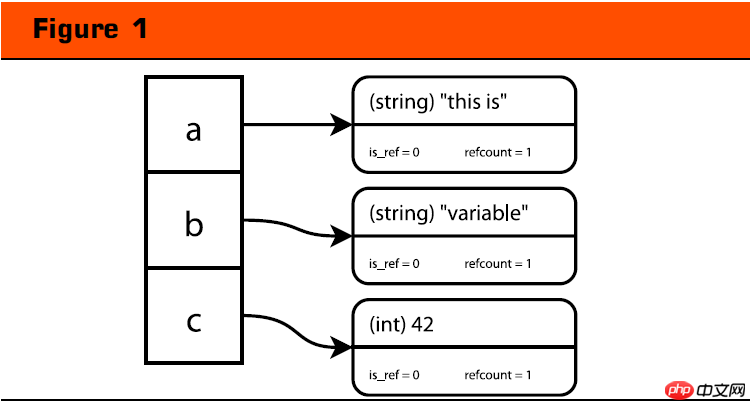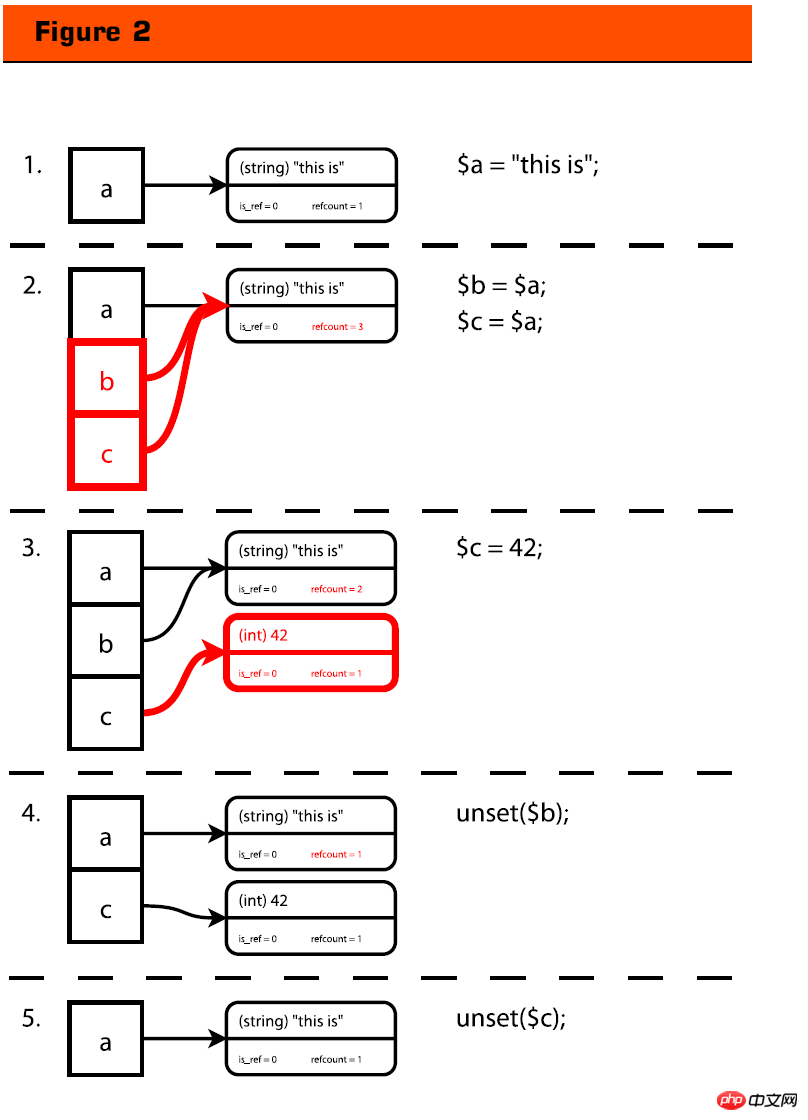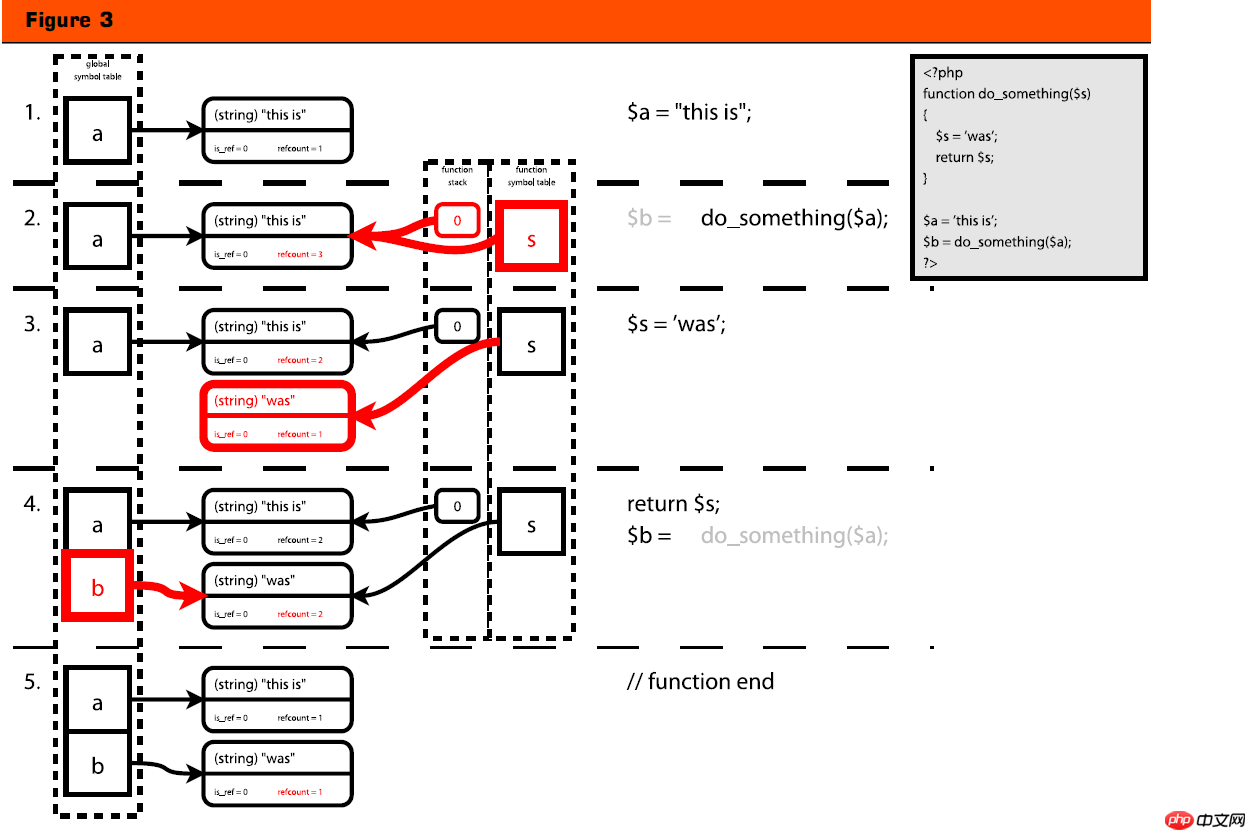Memory management of PHP variables
This article mainly introduces the memory management of PHP variables, which has certain reference value. Now I share it with everyone. Friends in need can refer to it
Every computer language needs some containers to save variables data. In some languages, variables have specific types, such as strings, arrays, objects, etc. For example, C and Pascal fall into this category. PHP has no such type. In PHP, a variable that is a string on one line may become a number on the next line. Variables can often be easily converted between different types, even automatically. A large part of the reason why PHP is a simple and powerful language is that it has weakly typed variables. But sometimes this can lead to some interesting problems.
Inside PHP, variables are stored in a container called zval. It contains not only the value of the variable, but also the type of the variable. Python, like PHP, also has a label to mark the variable type. The variable container contains some fields that the Zend engine uses to distinguish whether they are referenced or not. It also contains the reference count of this value.
Variables are stored in a symbol table equivalent to an associative array. This array is keyed by variable names and points to containers containing these variables. As shown in the figure below:

Reference counting
PHP tries to be smart when copying variables (such as $a = $b) some. "=" is also called the assignment operator. When performing an assignment operation, the Zend engine will not create a new variable window, but will increase the refcount field of the variable window. You can imagine that when this variable is a huge string or a huge array, this will How much memory is saved. As shown in the figure below:

Step 1: Variable a contains the text "this is". By default, the reference count is equal to 1
Step 2: Assign variable $a to $b and $c. There is no new variable container generated here, just refcount is increased by 1 each time a variable is assigned. Because two assignment operations are performed here, refcount will eventually become 3.
Now, maybe you are wondering what will happen when the variable $c changes. Depending on the value of refcount, it will be processed in two different ways. If refcount equals 1, the variable container will update its value (and perhaps its type as well). If refcount is greater than 1, a variable container containing the new value (and type) will be created. As shown in the third step in Figure 2, the refcount value of the variable container where the $a variable is located is subtracted by one. Now the refcount value is 2, and the refcount value of the newly created container is 1. When the unset function is used on a variable, the refcount value of the container where the variable is located will be reduced by one, as shown in step 4 of the figure. If the value of refcount is less than 1, the Zend Engine will translate the variable container, as shown in step 5 of the figure.
Passing Variables to Functions
In addition to the global symbol table shared by all scripts, each user-defined function will create its own symbol table when called. Used to store its own variables. When a function is called, the Zend engine will create such a symbol table, and the function table will be released when the function returns. A function either returns through a return statement or returns because the function ends (Translator's Note: Functions that do not return will return NULL by default). As shown below:

Figure 3 details how variables are passed to functions.
In the first step, we assign "thisis" to the variable $a, and then we pass this variable to the $s variable of the do_something() function.
In the second step, you can see that this is the same operation as variable assignment (similar to the $b = $a we mentioned in the previous section), except that it is stored in a different symbol table ( function symbol table), and the reference count is incremented by 2 instead of by 1. The reason is that the function stack also contains a reference to this variable container.
The third step, when we assign a new value to the variable $s, the refcount of the original variable container is reduced by 1, and a variable container containing the new value is created.
The fourth step is to return a variable through the return statement. The returned variable gets an entity from the global symbol table and increments its refcount by 1. When the function ends, the function's symbol table is destroyed. During the destruction process, the Zend engine will traverse each variable in the symbol table and reduce its refcount value. When the refount value of the variable container becomes 0, the variable container will be destroyed. As you can see, due to PHP's reference counting mechanism, the variable container is not copied from the function. If variable $s has not been modified in the third step, variables $a and $b will always point to the same variable container (the refcount of this container is 2). In this case, the statement $a = "this is" will not create a copy of the variable container.
Related recommendations:
php variable copy-on-write mechanism
The above is the detailed content of Memory management of PHP variables. For more information, please follow other related articles on the PHP Chinese website!

Hot AI Tools

Undresser.AI Undress
AI-powered app for creating realistic nude photos

AI Clothes Remover
Online AI tool for removing clothes from photos.

Undress AI Tool
Undress images for free

Clothoff.io
AI clothes remover

Video Face Swap
Swap faces in any video effortlessly with our completely free AI face swap tool!

Hot Article

Hot Tools

Notepad++7.3.1
Easy-to-use and free code editor

SublimeText3 Chinese version
Chinese version, very easy to use

Zend Studio 13.0.1
Powerful PHP integrated development environment

Dreamweaver CS6
Visual web development tools

SublimeText3 Mac version
God-level code editing software (SublimeText3)

Hot Topics
 PHP 8.4 Installation and Upgrade guide for Ubuntu and Debian
Dec 24, 2024 pm 04:42 PM
PHP 8.4 Installation and Upgrade guide for Ubuntu and Debian
Dec 24, 2024 pm 04:42 PM
PHP 8.4 brings several new features, security improvements, and performance improvements with healthy amounts of feature deprecations and removals. This guide explains how to install PHP 8.4 or upgrade to PHP 8.4 on Ubuntu, Debian, or their derivati
 How To Set Up Visual Studio Code (VS Code) for PHP Development
Dec 20, 2024 am 11:31 AM
How To Set Up Visual Studio Code (VS Code) for PHP Development
Dec 20, 2024 am 11:31 AM
Visual Studio Code, also known as VS Code, is a free source code editor — or integrated development environment (IDE) — available for all major operating systems. With a large collection of extensions for many programming languages, VS Code can be c
 Explain JSON Web Tokens (JWT) and their use case in PHP APIs.
Apr 05, 2025 am 12:04 AM
Explain JSON Web Tokens (JWT) and their use case in PHP APIs.
Apr 05, 2025 am 12:04 AM
JWT is an open standard based on JSON, used to securely transmit information between parties, mainly for identity authentication and information exchange. 1. JWT consists of three parts: Header, Payload and Signature. 2. The working principle of JWT includes three steps: generating JWT, verifying JWT and parsing Payload. 3. When using JWT for authentication in PHP, JWT can be generated and verified, and user role and permission information can be included in advanced usage. 4. Common errors include signature verification failure, token expiration, and payload oversized. Debugging skills include using debugging tools and logging. 5. Performance optimization and best practices include using appropriate signature algorithms, setting validity periods reasonably,
 PHP Program to Count Vowels in a String
Feb 07, 2025 pm 12:12 PM
PHP Program to Count Vowels in a String
Feb 07, 2025 pm 12:12 PM
A string is a sequence of characters, including letters, numbers, and symbols. This tutorial will learn how to calculate the number of vowels in a given string in PHP using different methods. The vowels in English are a, e, i, o, u, and they can be uppercase or lowercase. What is a vowel? Vowels are alphabetic characters that represent a specific pronunciation. There are five vowels in English, including uppercase and lowercase: a, e, i, o, u Example 1 Input: String = "Tutorialspoint" Output: 6 explain The vowels in the string "Tutorialspoint" are u, o, i, a, o, i. There are 6 yuan in total
 How do you parse and process HTML/XML in PHP?
Feb 07, 2025 am 11:57 AM
How do you parse and process HTML/XML in PHP?
Feb 07, 2025 am 11:57 AM
This tutorial demonstrates how to efficiently process XML documents using PHP. XML (eXtensible Markup Language) is a versatile text-based markup language designed for both human readability and machine parsing. It's commonly used for data storage an
 Explain late static binding in PHP (static::).
Apr 03, 2025 am 12:04 AM
Explain late static binding in PHP (static::).
Apr 03, 2025 am 12:04 AM
Static binding (static::) implements late static binding (LSB) in PHP, allowing calling classes to be referenced in static contexts rather than defining classes. 1) The parsing process is performed at runtime, 2) Look up the call class in the inheritance relationship, 3) It may bring performance overhead.
 What are PHP magic methods (__construct, __destruct, __call, __get, __set, etc.) and provide use cases?
Apr 03, 2025 am 12:03 AM
What are PHP magic methods (__construct, __destruct, __call, __get, __set, etc.) and provide use cases?
Apr 03, 2025 am 12:03 AM
What are the magic methods of PHP? PHP's magic methods include: 1.\_\_construct, used to initialize objects; 2.\_\_destruct, used to clean up resources; 3.\_\_call, handle non-existent method calls; 4.\_\_get, implement dynamic attribute access; 5.\_\_set, implement dynamic attribute settings. These methods are automatically called in certain situations, improving code flexibility and efficiency.
 PHP and Python: Comparing Two Popular Programming Languages
Apr 14, 2025 am 12:13 AM
PHP and Python: Comparing Two Popular Programming Languages
Apr 14, 2025 am 12:13 AM
PHP and Python each have their own advantages, and choose according to project requirements. 1.PHP is suitable for web development, especially for rapid development and maintenance of websites. 2. Python is suitable for data science, machine learning and artificial intelligence, with concise syntax and suitable for beginners.






